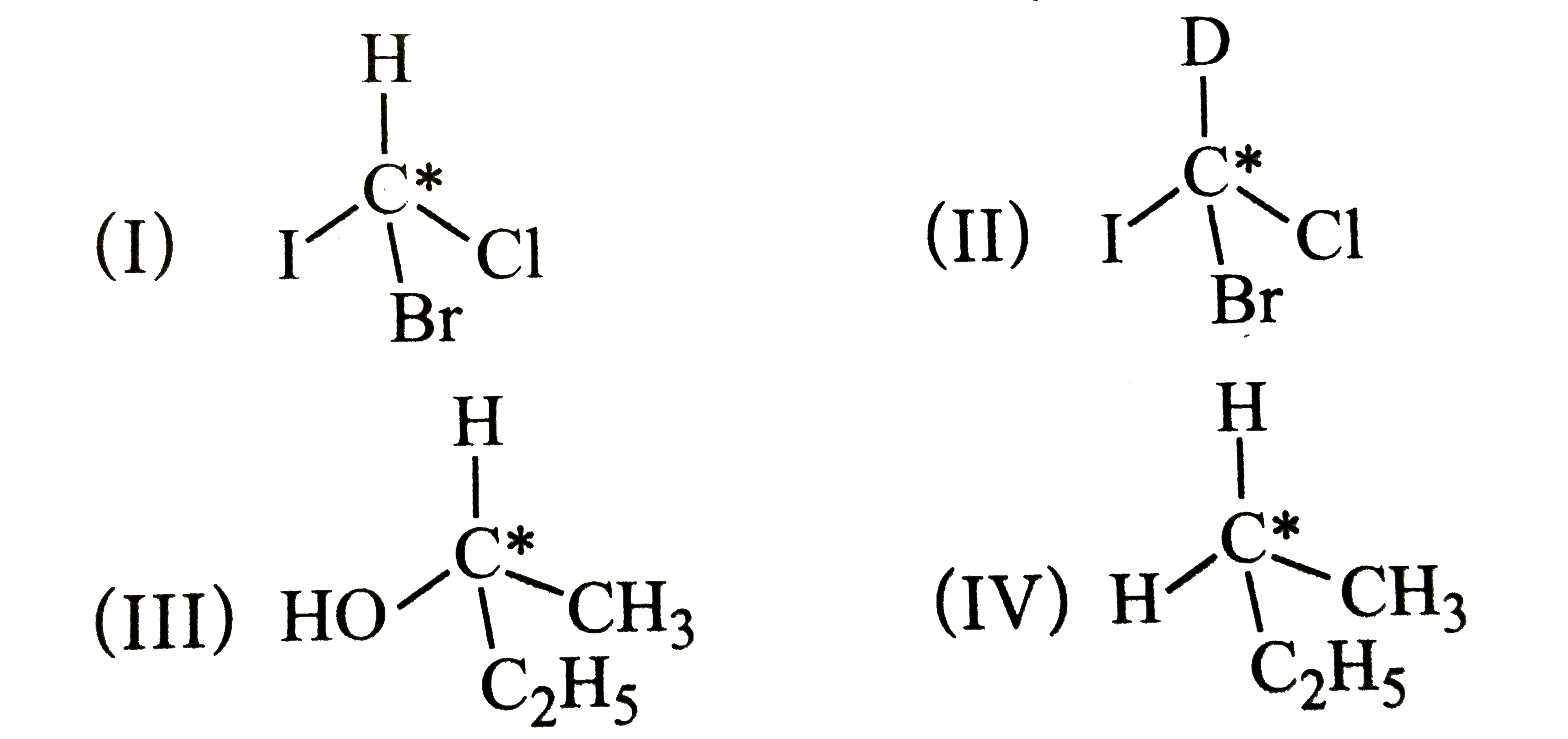In which of the followinng compounds the carbon marked with asterisk is expected to have greatest positive charge?
⋆CH3−CH2−Cl
⋆CH3−CH2−Mg+Cl−
⋆CH3−CH2−Br
⋆CH3−CH2−CH3
The correct Answer is:A
To determine which compound has the carbon marked with an asterisk expected to have the greatest positive charge, we will analyze the inductive effects of the substituents attached to the carbon in each option.
1. Identify the Compounds:
- We have four compounds with a carbon marked with an asterisk. Let's denote them as:
- Option 1: Ethyl chloride (CH3-CH2-Cl)
- Option 2: Grignard reagent (R-MgX)
- Option 3: Ethyl bromide (CH3-CH2-Br)
- Option 4: A saturated hydrocarbon (not specified in the transcript)
2. Analyze the Inductive Effect:
- The inductive effect is the permanent effect of electron-withdrawing or electron-donating groups through sigma bonds.
- Chlorine (Cl) and bromine (Br) are both electronegative atoms that exhibit a -I (inductive withdrawal) effect.
3. Compare Chlorine and Bromine:
- Chlorine is more electronegative than bromine, which means that it will exert a stronger -I effect. Therefore, in ethyl chloride (Option 1), the carbon attached to chlorine will have a greater positive charge compared to the carbon in ethyl bromide (Option 3) due to chlorine's stronger electron-withdrawing ability.
4. Evaluate the Grignard Reagent (Option 2):
- In the Grignard reagent (R-MgX), the carbon (R) is bonded to magnesium, which is a metal. In this case, the carbon atom will carry a partial negative charge (δ-) because magnesium (Mg) carries a partial positive charge (δ+). Therefore, this option does not contribute to a positive charge on the carbon.
5. Consider the Saturated Hydrocarbon (Option 4):
- The saturated hydrocarbon does not have any strong electron-withdrawing groups. The carbon in this compound is likely to have a very minimal positive charge, if any, due to the lack of electronegative substituents.
6. Conclusion:
- Based on the analysis, the carbon in ethyl chloride (Option 1) will have the greatest positive charge due to the strong -I effect of chlorine.
Final Answer:
The compound in which the carbon marked with an asterisk is expected to have the greatest positive charge is Option 1: Ethyl chloride (CH3-CH2-Cl).
- We have four compounds with a carbon marked with an asterisk. Let's denote them as:
- Option 1: Ethyl chloride (CH3-CH2-Cl)
- Option 2: Grignard reagent (R-MgX)
- Option 3: Ethyl bromide (CH3-CH2-Br)
- Option 4: A saturated hydrocarbon (not specified in the transcript)
- The inductive effect is the permanent effect of electron-withdrawing or electron-donating groups through sigma bonds.
- Chlorine (Cl) and bromine (Br) are both electronegative atoms that exhibit a -I (inductive withdrawal) effect.
- Chlorine is more electronegative than bromine, which means that it will exert a stronger -I effect. Therefore, in ethyl chloride (Option 1), the carbon attached to chlorine will have a greater positive charge compared to the carbon in ethyl bromide (Option 3) due to chlorine's stronger electron-withdrawing ability.
- In the Grignard reagent (R-MgX), the carbon (R) is bonded to magnesium, which is a metal. In this case, the carbon atom will carry a partial negative charge (δ-) because magnesium (Mg) carries a partial positive charge (δ+). Therefore, this option does not contribute to a positive charge on the carbon.
- The saturated hydrocarbon does not have any strong electron-withdrawing groups. The carbon in this compound is likely to have a very minimal positive charge, if any, due to the lack of electronegative substituents.
- Based on the analysis, the carbon in ethyl chloride (Option 1) will have the greatest positive charge due to the strong -I effect of chlorine.
The compound in which the carbon marked with an asterisk is expected to have the greatest positive charge is Option 1: Ethyl chloride (CH3-CH2-Cl).
Topper's Solved these Questions
- BOOK - NCERT FINGERTPS ENGLISHCHAPTER - ORGANIC CHEMISTRY-SOME BASIC PRINCIPLES AND TECHNIQUES EXERCISE - Assertion & Reason13videos
ORGANIC CHEMISTRY-SOME BASIC PRINCIPLES AND TECHNIQUES
- BOOK - NCERT FINGERTPS ENGLISHCHAPTER - ORGANIC CHEMISTRY-SOME BASIC PRINCIPLES AND TECHNIQUES EXERCISE - Tetravalence Of Carbon : Shape Of Organic Compounds5videos
ORGANIC CHEMISTRY-SOME BASIC PRINCIPLES AND TECHNIQUES
- BOOK - NCERT FINGERTPS ENGLISHCHAPTER - ORGANIC CHEMISTRY-SOME BASIC PRINCIPLES AND TECHNIQUES EXERCISE - Assertion And Reason12videos
ORGANIC CHEMISTRY-SOME BASIC PRINCIPLES AND TECHNIQUES
- BOOK - NCERT FINGERTPS ENGLISHCHAPTER - HYDROGEN EXERCISE - Assertion And Reason15videos
HYDROGEN
- BOOK - NCERT FINGERTPS ENGLISHCHAPTER - PRACTICE PAPER 1EXERCISE - Practice Paper 144videos
PRACTICE PAPER 1
Similar Questions
In which of the following compounds the carbon marked with asterisk is expected to have greatest positive charge ?
View SolutionElectronegativity of carbon atoms depends upon their state of hybridisation. In which of the following compounds, the carbon marked with asterisk is most electronegative ?
View Solution
Knowledge Check
- Question 1 - Select One
Electronegativity of carbon atoms depends upon their state of hybridisation. In which of the following compounds, the carbon marked with asterisk is most electronegative?
ACH3−CH2−CH2−CH3BCH3−⋆CH=CH−CH3CCH3−CH2−C≡⋆CHDCH3−CH2−CH=⋆CH2 - Question 2 - Select One
Which of the following is a 4-carbon compound?
AOxaloacetic acidBPhosphoglyceric acidCRibulose bisphosphateDPhosphoenol pyruvate - Question 3 - Select One
In which of the following compounds carbon is in highest oxidation state ?
ACH3ClBCCl4CCHCl3DCH2Cl2
In which of the following molecules carbon atom marked with asterisk (*) is asymmetric?
 View Solution
View SolutionIn which of the following molecules carbon atom marked with asterik (*) is asymmetric ?
 View Solution
View SolutionWhich of the following is a 4-carbon compound?
View SolutionIn which of the following compounds the oxidation number of carbon is maximum
View SolutionWhich of the following compounds is expected to be the most ionic?
View Solution

